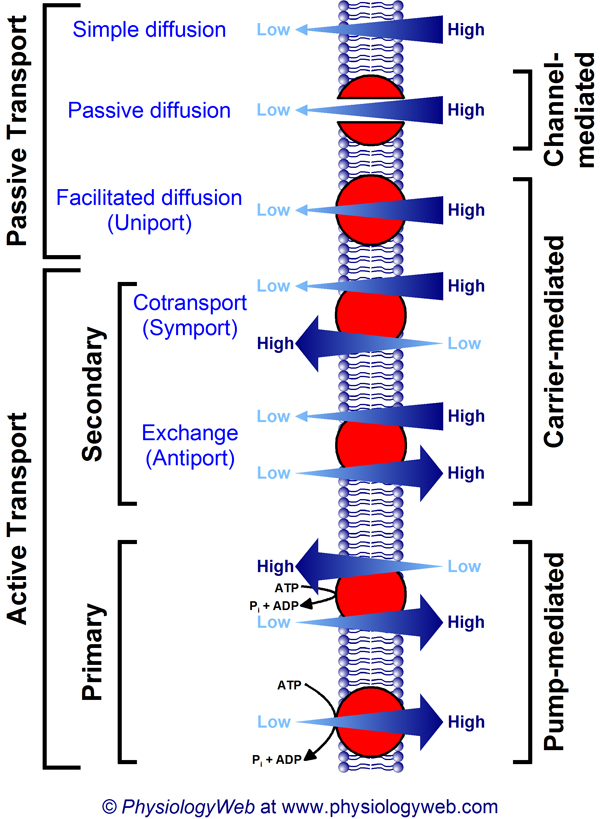 |
 |
| Physiology? | Figures & Illustrations | Test Questions | Daily Quiz | Calculators | Physiology Tutor | Glossary |
 |
 |
 |
 |
 |
 |

Physiology Illustration
Transport across biological membranes.
Transport across biological membranes.

Transport across biological membranes.
Only a limited number of molecules can cross biological membranes without the aid of transport proteins. These are lipid-soluble molecules such as steroid molecules, oxygen (O2), carbon dioxide (CO2), and a few small polar molecules such as water, ethanol, glycerol, and urea. On the other hand, ions (e.g., Na+, K+, Ca2+, Cl−, H+, etc.), most polar molecules (e.g., glucose, amino acids, etc.), and other biologically relevant molecules must utilize membrane transport proteins to cross biological membranes (see Permeability properties of pure lipid bilayers). Transport proteins, referred to as transporters or carriers, may be passive transporters or active transporters.
Transport across the membrane may be passive or active. Passive transport describes movement across biological membranes down a concentration gradient from the side of the membrane where the concentration is higher to the side of the membrane where the concentration is lower. Passive transport does not require direct energy expenditure; the free energy required to drive passive transport is provided by an existing concentration or electrochemical gradient across the membrane. On the other hand, active transport describes movement across biological membranes against a concentration gradient from the side of membrane where the concentration is lower to the side of the membrane where the concentration is higher. Active transport requires direct input of energy, where the free energy required for active transport is provided by hydrolysis of ATP (primary active transport), or by an existing ion gradient (secondary active transport). Secondary active transport may be further classified as costransport (also referred to as symport) or exchange (also referred to as antiport).
While lipid-soluble molecules may cross biological membranes passively down a concentration gradient without the aid of transport proteins, ions and other molecules must utilize channels or facilitative transporters to passively cross the membrane down a concentration gradient. Notable examples of channels are channels for water, Na+, K+, Ca2+, Cl−, etc. An important example of facilitative transporters is the glucose transporters (GLUT) found in the plasma membrane of all cells of the body. Facilitative transporters are also referred to as uniporters. Transport mediated by facilitative transporters (uniporters) is referred to as facilitated diffusion or uniport.
Active transporters may be primary active transporters (pumps) or secondary active transporters (cotransporters and exchangers). Primary active transporters hydrolyze ATP and harness the energy released from ATP hydrolysis to drive the transport of ions against concentration or electrochemical gradients. Notable examples of primary active transporters are the ubiquitous Na+/K+ ATPase (also known as the sodium pump), gastric proton pump (H+/K+ ATPase), and vesicular H+-ATPase. Secondary active transporters (cotransporters and exchangers) use an existing ion gradient (usually, but not always, Na+ or H+), where the ion is referred to as the driving ion. Secondary active transporters couple the movement of the driving ion across the membrane down its electrochemical gradient to the movement of another ion or molecule across the membrane against a concentration or electrochemical gradient. The ion or molecule that is transported against a concentration or electrochemical gradient is referred to as the driven ion/molecule. In the case of cotransporters (also referred to symporters), the driving and driven species move in the same direction across the membrane. Examples of cotransporters include the intestinal and renal Na+/glucose cotransporter (SGLT), thyroid Na+/I− symporter (NIS), and Na+/K+/2Cl− cotransporter, and several amino acid and neurotransmitter transporters. In the case of exchangers (also referred to antiporters), the driving and driven species move in opposite directions across the membrane. Examples of exchangers include the Na+/H+ exchanger, Na+/Ca2+ exchanger, and Cl−/bicarbonate exchanger.
ATP, adenosine triphosphate; ADP, adenosine diphosphate, Ca2+, calcium; Cl−, chloride; H+, proton, I−, iodide, K+, potassium, Na+, sodium, Pi, inorganic phosphate.
See also:
Lipid Bilayer Permeability
Secondary Active Transport
Summary of Membrane Transport Processes
Permeability properties of pure lipid bilayers
Transport across the membrane may be passive or active. Passive transport describes movement across biological membranes down a concentration gradient from the side of the membrane where the concentration is higher to the side of the membrane where the concentration is lower. Passive transport does not require direct energy expenditure; the free energy required to drive passive transport is provided by an existing concentration or electrochemical gradient across the membrane. On the other hand, active transport describes movement across biological membranes against a concentration gradient from the side of membrane where the concentration is lower to the side of the membrane where the concentration is higher. Active transport requires direct input of energy, where the free energy required for active transport is provided by hydrolysis of ATP (primary active transport), or by an existing ion gradient (secondary active transport). Secondary active transport may be further classified as costransport (also referred to as symport) or exchange (also referred to as antiport).
While lipid-soluble molecules may cross biological membranes passively down a concentration gradient without the aid of transport proteins, ions and other molecules must utilize channels or facilitative transporters to passively cross the membrane down a concentration gradient. Notable examples of channels are channels for water, Na+, K+, Ca2+, Cl−, etc. An important example of facilitative transporters is the glucose transporters (GLUT) found in the plasma membrane of all cells of the body. Facilitative transporters are also referred to as uniporters. Transport mediated by facilitative transporters (uniporters) is referred to as facilitated diffusion or uniport.
Active transporters may be primary active transporters (pumps) or secondary active transporters (cotransporters and exchangers). Primary active transporters hydrolyze ATP and harness the energy released from ATP hydrolysis to drive the transport of ions against concentration or electrochemical gradients. Notable examples of primary active transporters are the ubiquitous Na+/K+ ATPase (also known as the sodium pump), gastric proton pump (H+/K+ ATPase), and vesicular H+-ATPase. Secondary active transporters (cotransporters and exchangers) use an existing ion gradient (usually, but not always, Na+ or H+), where the ion is referred to as the driving ion. Secondary active transporters couple the movement of the driving ion across the membrane down its electrochemical gradient to the movement of another ion or molecule across the membrane against a concentration or electrochemical gradient. The ion or molecule that is transported against a concentration or electrochemical gradient is referred to as the driven ion/molecule. In the case of cotransporters (also referred to symporters), the driving and driven species move in the same direction across the membrane. Examples of cotransporters include the intestinal and renal Na+/glucose cotransporter (SGLT), thyroid Na+/I− symporter (NIS), and Na+/K+/2Cl− cotransporter, and several amino acid and neurotransmitter transporters. In the case of exchangers (also referred to antiporters), the driving and driven species move in opposite directions across the membrane. Examples of exchangers include the Na+/H+ exchanger, Na+/Ca2+ exchanger, and Cl−/bicarbonate exchanger.
ATP, adenosine triphosphate; ADP, adenosine diphosphate, Ca2+, calcium; Cl−, chloride; H+, proton, I−, iodide, K+, potassium, Na+, sodium, Pi, inorganic phosphate.
See also:
Lipid Bilayer Permeability
Secondary Active Transport
Summary of Membrane Transport Processes
Permeability properties of pure lipid bilayers
Posted: Saturday, February 20, 2016
Last updated: Saturday, February 20, 2016
Last updated: Saturday, February 20, 2016